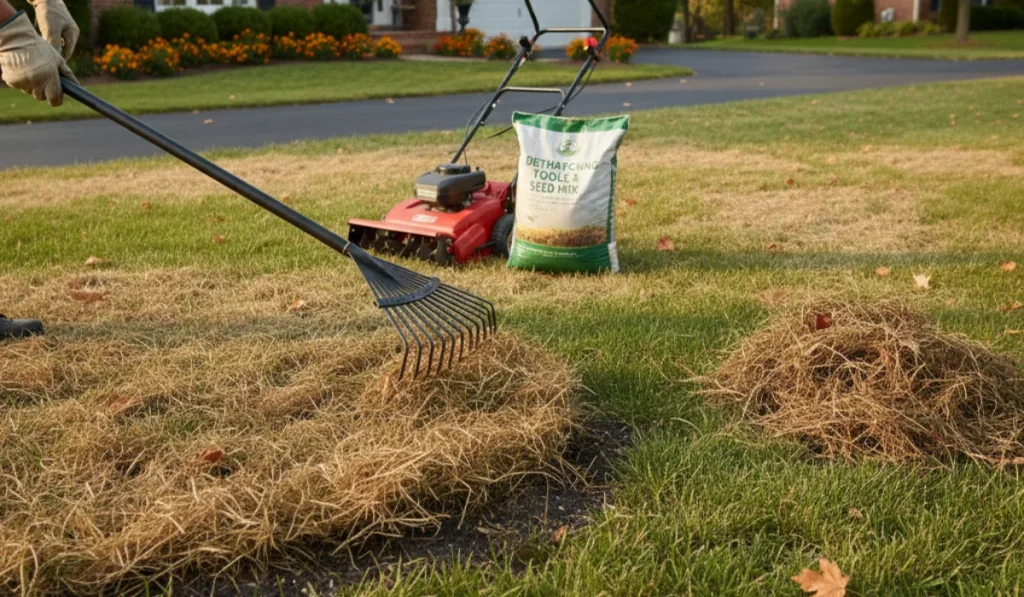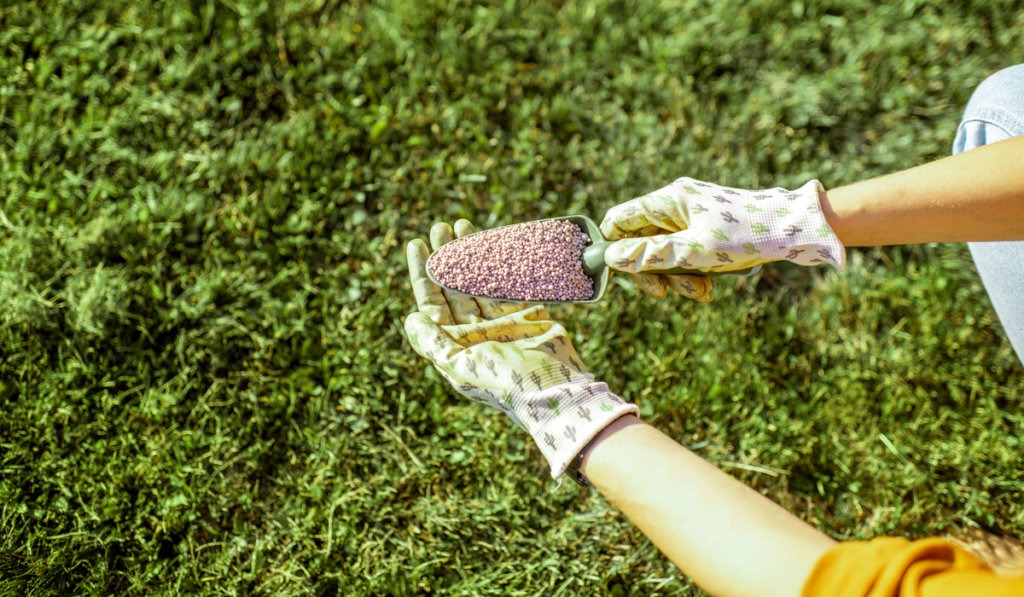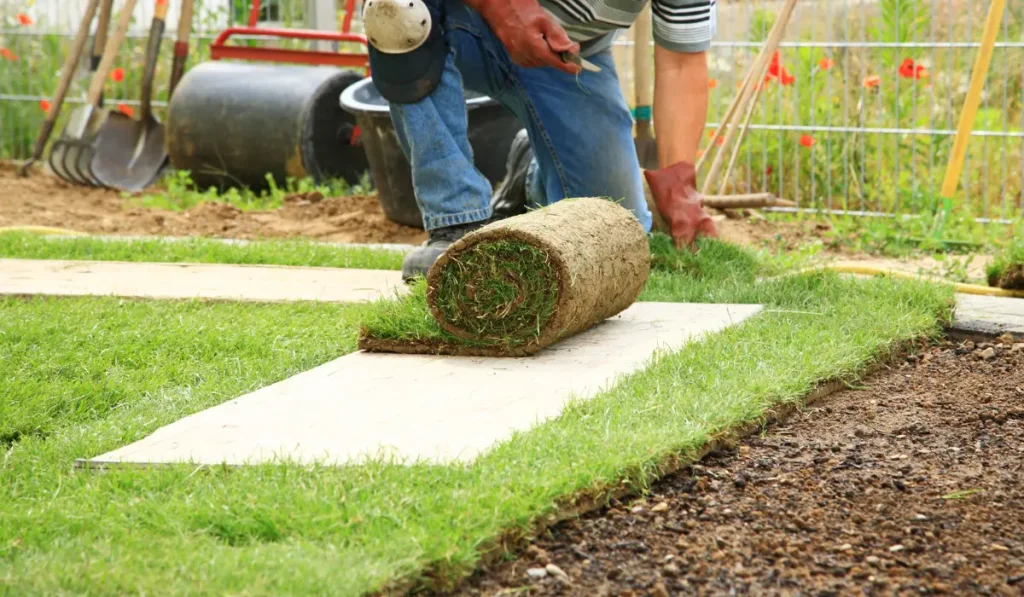Laying new sod is an exciting step toward a healthy, green lawn. Fertilizer is an important part of lawn care, but it needs to be used correctly. Too much fertilizer or the wrong type can damage your sod and even kill it.
In this guide, we’ll show homeowners how to fertilize new sod safely and keep it looking its best.
Key Takeaways
- Fertilizer burn, caused by overfertilizing new sod, dries grass and damages roots, especially in hot summer weather conditions.
- Starter fertilizers high in phosphorus and potassium support root growth and stress resistance, helping new sod establish successfully.
- Correct timing and application, including even spreading and deep watering, ensure proper sod development.
- Long-term sod care, such as mowing, weed control, aeration, watering, and overseeding, keeps lawns healthy, green, and vibrant.
Can Fertilizer Hurt New Sod?
Yes, using fertilizer the wrong way can harm new sod. Overfertilizing can cause fertilizer burn, which happens when the salts in the fertilizer dry out the grass. This is a big problem for sod since its root system is still developing.
Hot weather, like during the summer heat, can make fertilizer burn even worse.
How to Fertilize New Sod
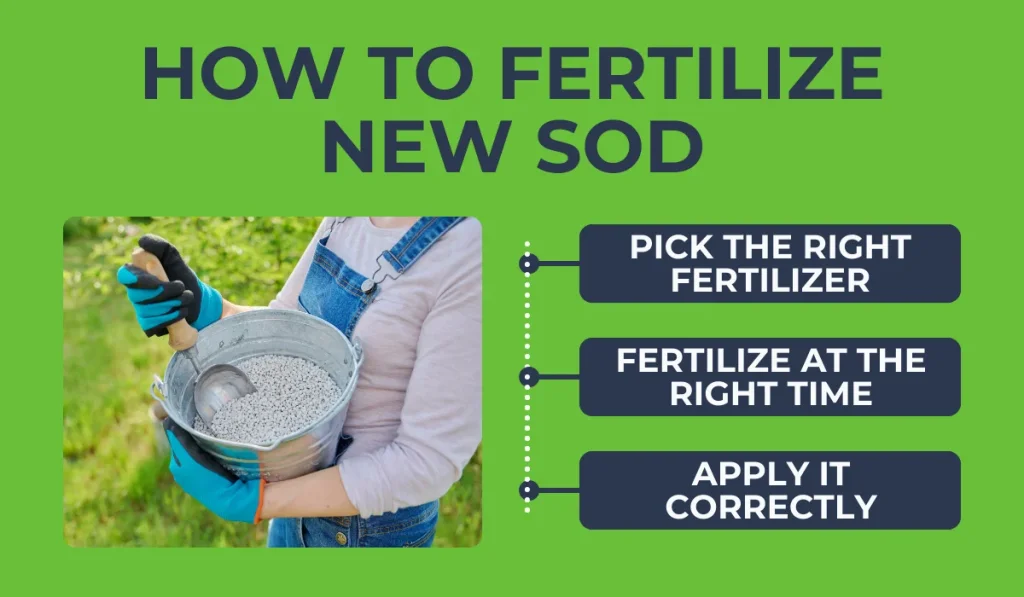
With the right nutrients, fertilizing new sod is key to helping it establish strong roots and grow into a healthy lawn. Here’s how you can set your sod up for long-term success:
1. Pick the Right Fertilizer
New sod needs a special type of fertilizer called a starter fertilizer.
These non-regular fertilizers are high in phosphorus (the “P” in NPK), which helps with root development. Potassium (the “K” in NPK) is also important because it helps the grass handle stress.
Look for an NPK ratio like 10-20-10 or 12-24-12. Use slow-release or granular fertilizer for steady nutrient delivery with its granules.
Other types of fertilizers to choose from include:
- Liquid Fertilizers: Works quickly but can cause damage if overused. Follow the instructions closely.
- Organic Fertilizer: A gentler option that’s less likely to cause fertilizer burn and improves soil health over time.
2. Fertilize at the Right Time
The time of year matters when fertilizing new grass.
For most grass types, you can add starter fertilizer before sod installation. After laying sod, wait 2–4 weeks before applying more fertilizer to avoid overwhelming the grass.
Cool-season grasses like tall fescue or Kentucky bluegrass do best in spring or fall. On the other hand, warm-season grasses like Bermuda, St. Augustine, and Zoysia thrive in late spring or summer.
3. Apply It Correctly
Spread the fertilizer evenly with a broadcast spreader to avoid missed spots or overfertilizing one area. Water deeply right after fertilizing to wash nutrients into the soil and reduce the risk of fertilizer burn.
Common Problems and How to Avoid Them
Keeping your new sod healthy starts with avoiding common mistakes. Two issues to watch out for are fertilizer burn and soil imbalances.
Here’s how to prevent them and give your lawn the best chance to thrive:
Fertilizer Burn
Fertilizer burn shows up as brown or yellow spots, dry grass, or crispy blades. To prevent this, don’t overfertilize. Follow the instructions on the fertilizer bag. Stick to the recommended amounts for the size of your yard (in square feet).
Water your lawn well after fertilizing.
Soil Problems
A soil test before sod installation can help you figure out what your soil type needs.
For example, sandy soil might need extra phosphorus, while clay soil may require potassium. This makes it easier to pick the best fertilizer for your lawn.
Best Practices for Sod Care
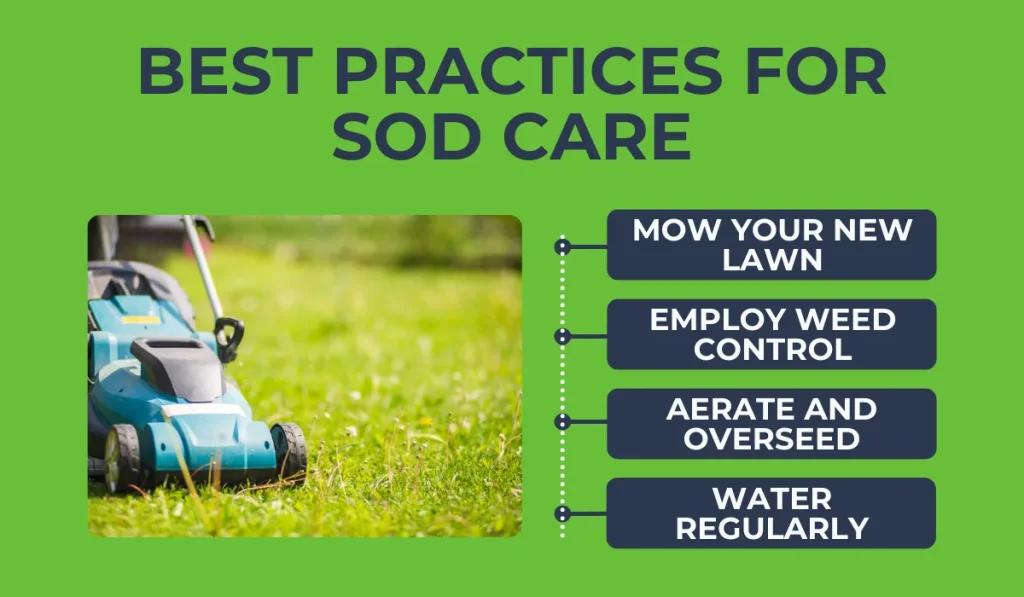
Caring for new sod requires the right steps to ensure strong growth and long-term health. Here’s how to help your lawn establish quickly and stay green and vibrant:
Mow Your New Lawn
Before mowing your new lawn, make sure the sod has rooted, which usually takes 2–3 weeks. Cutting too early can tear up the sod, causing gaps and uneven growth.
When it’s time to mow, set your mower blades high to avoid cutting too much of the grass. A good rule is to cut no more than one-third of the grass height at a time.
Using sharp blades will make clean cuts, helping the grass recover faster and reducing stress on your new sod.
Employ Weed Control
Emergent weeds can quickly appear in new sod because fresh soil provides ideal conditions for their growth. Applying herbicides too soon, however, can damage the grass and slow its establishment.
To manage weeds effectively, focus on creating a healthy lawn. Regular watering and proper fertilization encourage the grass to grow thick, naturally crowding out weeds. If any weeds do show up, hand-pull them or use a weed treatment that’s labeled safe for new sod.
Aerate and Overseed
Aeration boosts the health of your sod by improving soil drainage and letting air, water, and nutrients reach the roots. This is especially useful if your soil is compacted or clay-heavy.
Overseeding adds grass seed to thin spots, making your lawn thicker and healthier over time. This process is particularly helpful for cool-season grasses, which benefit from seasonal overseeding to maintain their density and color.
Water Regularly
Watering is one of the most important steps in caring for new sod.
During the first few weeks, water lightly but often to keep the topsoil consistently moist. Using a sprinkler ensures even coverage and prevents dry spots. Be careful not to overwater, as this can lead to shallow root growth or disease.
Once the sod starts rooting, reduce the frequency and water deeper to encourage strong root development and prepare your lawn for long-term health.
Protect Your New Sod with Expert Care
Fertilizing new sod doesn’t have to be difficult. By using the right products, applying them correctly, and following good sod care practices, you can avoid fertilizer burn and enjoy a beautiful, healthy lawn.
For more tips and expert advice on lawn maintenance, check out lawn care guides or talk to a professional about maintaining your sod, like SodLawn. They can help you pick the best lawn fertilizer and ensure your yard stays green and healthy.
Frequently Asked Questions
Can I use a regular fertilizer if I don’t have a starter fertilizer?
If you don’t have a starter fertilizer, you can use a balanced fertilizer like 10-10-10.
Apply it sparingly and water deeply right after to avoid fertilizer burn. Starter fertilizers are still better for new sod because they promote stronger root development.
How long should I wait before walking on new sod?
Wait 3–4 weeks before walking on new sod to give the roots time to grow into the soil. Walking too soon can damage the sod, causing gaps, uneven growth, and stress that makes it harder for the grass to thrive.
Do I need to fertilize the sod if it’s installed in winter?
Fertilizing sod in winter depends on the grass type. Cool-season grasses may benefit from winter fertilization, while warm-season grasses usually go dormant and need less care. A soil test can help you decide if your lawn needs nutrients during winter.

